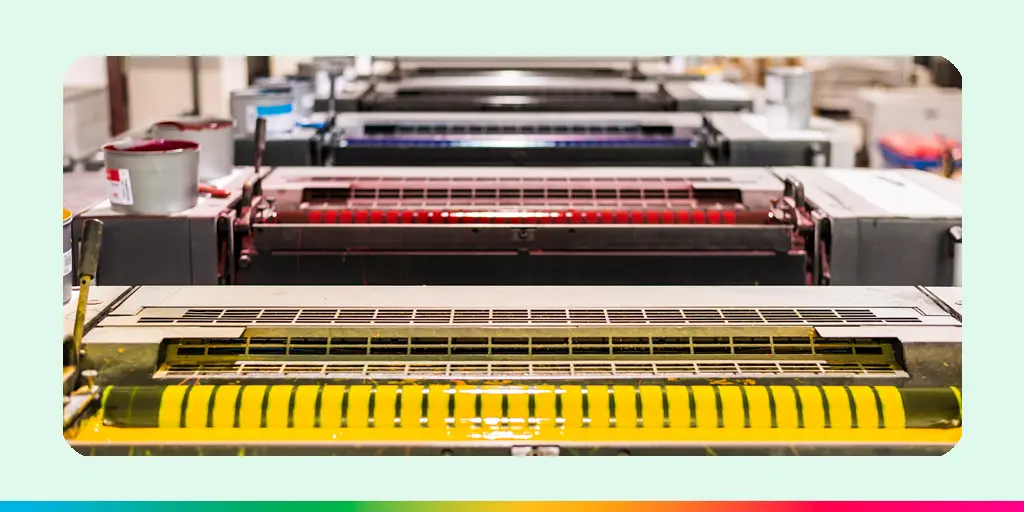
Before delving into the specifics of ink contamination in pressrooms, you’ll want to know what it is and some basic preventive measures you can implement to reduce the frequency and help your bottom line.
Ink contamination is when you experience unwanted ink colorants in your ink fountains and press rollers, typically from a previous job, accidental mixing, or impurities or foreign materials in the ink. Contamination can lead to various issues, the most common being color inconsistencies and an overall poor-quality print.
Identifying causes of ink contamination requires proper maintenance of the pressroom and equipment, correct handling of supplies and constant vigilance. Staff should monitor the ink characteristics, print output and certificate of analysis (COA) ink supply systems. To identify ink contamination in pressrooms, you can practice the following:
To prevent ink contamination on the press, implement general measures that fortify the pressroom against potential causes of ink contamination. Ink contamination can occur in several ways. Here are some of the most common reasons:
Ink contamination is more than a mere inconvenience or minor color alteration. It can have far-reaching effects on the print quality and a company’s finances and reputation. In addition to understanding the implications of ink contamination, having a state-of-the-art color management software suite can assist in achieving color targets.
Preparing the press correctly is essential to provide accurate prints and precise colors. Ink contamination is a massive threat to color accuracy as it can lead to noticeable distortions in the final print. The contamination can alter the ink composition and consequently change the color, leading to one or more variations in the shade. It can also cause irregularities in the printed images and texts due to uneven distribution.
Thankfully, understanding color theory, the nature of color and the desired tones means that this knowledge can guide you in identifying contaminated ink. Even the slightest deviation from the expected color composition becomes glaringly apparent for those with a keen eye for color. Picking up on these subtle alterations can lead to timely corrective action.
Further, regularly comparing prints to proofs and legacy jobs lets you quickly pick up on deviations from the benchmarks. It can help you avoid further waste and prevent contamination from affecting additional runs.
Ink contamination puts you at risk of not meeting the Idealliance G7® technical specifications. These specs provide a calibration method that ensures standardization in printing processes to achieve consistent and predictable color reproduction. Print service providers and other pressrooms can receive the various G7® certifications and become part of the directory of printing companies that meet these standards.
Additionally, ink contamination could mean failing to meet the International Organization for Standardization (ISO) standards. The ISO develops and publishes various globally applicable standards and provides precise requirements for industry-applicable standards.
Two main standards affect the print industry. ISO 12647-2:2013 discusses the parameters and requirements for color accuracy and reproduction, printing conditions and color measurement. For offset printing, ISO 3664:2009 oversees viewing conditions. Ink contamination will directly affect ISO 12647 compliance and indirectly lead to non-compliance with ISO 3664.
Ink contamination can begin as a matter of foreign particles impacting the purity of your ink and grow into several other issues, including financial and reputational effects. Knowing what to look out for and understanding the best practices to prevent ink contamination in pressrooms can position you to avoid the following consequences:
Ensure your team systematically implements these and other best practices to prevent ink contamination. You will want regular equipment checks, including standard and routine maintenance and cleaning procedures. Additionally, train your pressroom staff to identify the causes and signs of ink contamination. Finally, thorough and intentional cleaning must be routine to ensure sustained print quality.
Thankfully, you can put several measures in place to help prevent ink contamination in your pressroom, including the following:
Regular checks on your pressroom equipment are an excellent and proactive means of keeping your presses running smoothly and avoiding potential ink contamination. Some of the steps to checking your equipment should include:
Training employees on ink contamination prevention and fostering an awareness culture in the print shop are key aspects of preventing ink contamination and maintaining general cleanliness and efficiency in the pressroom. You may want to train your employees on several elements, such as safety precautions, accountability, monitoring and standard operating procedures (SOPs), though the following are likely the most crucial:
Proper cleaning practices are pivotal in maintaining high print quality and preventing ink contamination. Best cleaning practices also prolong your equipment life spans and general work environment safety. There are numerous elements in a pressroom that require cleaning, and you will need to establish adequate measures and schedules, though you should consider the following:
At FUJIFILM Graphic Communication, we provide high-quality and technically advanced print solutions for pressrooms like yours. We constantly strive for purpose-driven innovation to add improved value to our offerings, which is apparent in the glowing customer testimonials we receive. You can explore our pressroom product range today, or feel free to request a demo for a product of interest.
To get in touch, you can complete our contact form or call us at 800-877-0555, and we will happily answer any questions and advise you on the best solution for your needs.